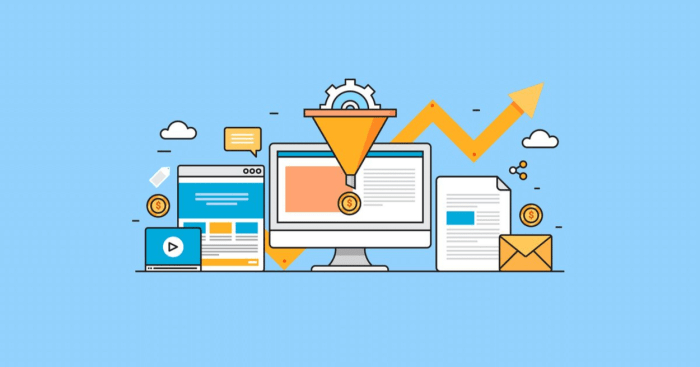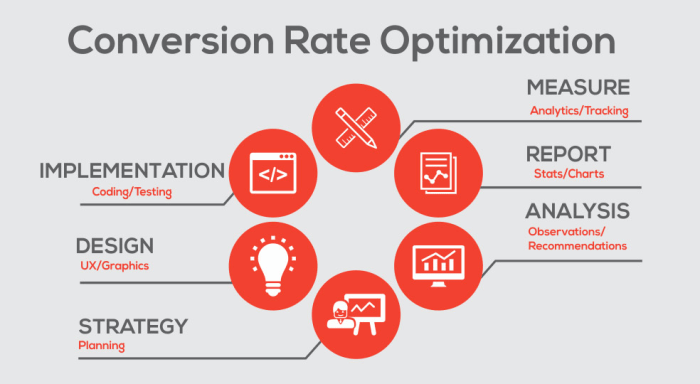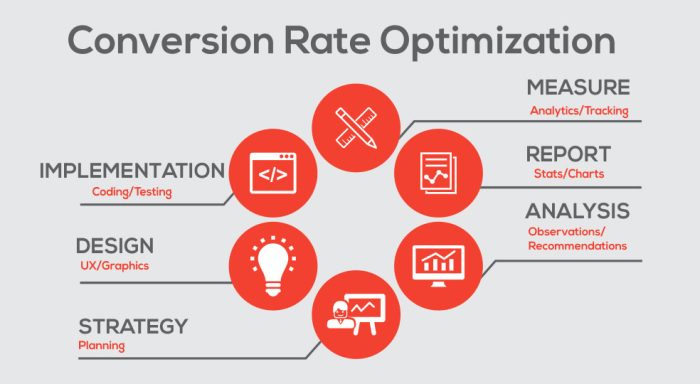Optimizing Conversion Rates kicks off our journey into maximizing business success through strategic online improvements. From understanding key metrics to leveraging data, this guide will help you ace the art of conversion rates optimization.
Introduction to Conversion Rates Optimization: Optimizing Conversion Rates

In the world of online businesses, conversion rates refer to the percentage of website visitors who take a desired action, such as making a purchase, signing up for a newsletter, or filling out a contact form. It is a crucial metric that indicates how effective a website is at turning visitors into customers or leads.
Optimizing conversion rates is essential for business success as it directly impacts the bottom line. By improving the conversion rates, businesses can generate more revenue, increase customer acquisition, and maximize the return on investment for marketing campaigns.
Importance of Conversion Rate Optimization
Effective conversion rate optimization can make a significant difference in various industries. Here are some examples of industries where optimizing conversion rates is crucial:
- E-commerce: For online retailers, increasing conversion rates can lead to higher sales and improved profitability.
- Software as a Service (SaaS): In the SaaS industry, optimizing conversion rates can help in acquiring more paying customers and reducing churn rate.
- Lead Generation: Companies that rely on lead generation, such as insurance or real estate agencies, can benefit from higher conversion rates in turning leads into customers.
Understanding Conversion Rate Metrics

In the world of digital marketing, understanding conversion rate metrics is crucial for optimizing your website’s performance and increasing sales. By measuring key metrics, you can identify areas of improvement and make data-driven decisions to enhance the user experience.
Key Metrics Used to Measure Conversion Rates
- Conversion Rate: This metric calculates the percentage of website visitors who complete a desired action, such as making a purchase or signing up for a newsletter. It is calculated by dividing the number of conversions by the total number of visitors and multiplying by 100.
- Bounce Rate: The bounce rate measures the percentage of visitors who navigate away from your site after viewing only one page. A high bounce rate indicates that visitors are not engaging with your content or finding what they are looking for.
- Click-Through Rate (CTR): CTR measures the percentage of users who click on a specific link, ad, or call-to-action. It is calculated by dividing the number of clicks by the number of impressions and multiplying by 100.
Conversion Rate = (Number of Conversions / Total Number of Visitors) x 100
Tools for Tracking and Analyzing Conversion Rate Metrics, Optimizing Conversion Rates
- Google Analytics: A powerful tool for tracking website traffic, user behavior, and conversion rates. It provides detailed insights into visitor demographics, source of traffic, and conversion paths.
- Hotjar: This tool allows you to visualize user behavior on your site through heatmaps, recordings, and feedback polls. It helps identify areas of friction and opportunities for optimization.
- Crazy Egg: Another tool for analyzing user behavior through heatmaps and scroll maps. It provides valuable insights into how visitors interact with your website and where improvements can be made.
Strategies for Optimizing Conversion Rates
When it comes to optimizing conversion rates, there are several key strategies that can make a significant impact on the success of your website. One of the most important tactics is A/B testing, which allows you to experiment with different elements on your site to see what resonates best with your audience.
The Significance of A/B Testing in Improving Conversion Rates
A/B testing involves creating two versions of a webpage (A and B) with different elements, such as headlines, images, or call-to-action buttons, and then measuring which version performs better in terms of conversions. This data-driven approach helps you make informed decisions about what changes to implement to improve your conversion rates.
The Impact of Website Design and User Experience on Conversion Rates
Your website design and user experience play a crucial role in determining whether visitors will convert into customers. A clean, user-friendly design that guides visitors towards your call-to-action buttons can significantly increase conversion rates. Make sure your site is easy to navigate, loads quickly, and provides a seamless experience across all devices.
Tips for Creating Compelling Call-to-Action Buttons that Drive Conversions
- Use action-oriented language that prompts visitors to take a specific action, such as “Shop Now” or “Sign Up Today.”
- Make your call-to-action buttons stand out by using contrasting colors that draw attention.
- Place your call-to-action buttons strategically on your site, such as above the fold or at the end of a product description.
- Experiment with different button sizes, shapes, and text to see what resonates best with your audience.
Leveraging Data for Conversion Rate Optimization
Data analytics plays a crucial role in identifying areas for improvement in conversion rates. By analyzing user behavior, traffic sources, and other relevant metrics, businesses can gain valuable insights to optimize their conversion rates.
Utilizing Customer Feedback and Surveys
Customer feedback and surveys are essential tools for understanding customer preferences and pain points. By collecting feedback through surveys, businesses can identify areas of improvement and tailor their strategies to better meet customer needs.
- Implementing feedback forms on websites to gather customer opinions and suggestions.
- Analyzing customer surveys to identify common trends and areas for improvement.
- Utilizing feedback to make data-driven decisions that lead to improved conversion rates.
Examples of Successful Data-Driven Companies
Amazon:
Amazon uses data analytics to personalize user experience, recommend products, and optimize conversion rates.
Netflix:
Netflix analyzes user behavior to recommend personalized content, improving user engagement and conversion rates.
Uber:
Uber uses data to optimize pricing strategies, driver allocation, and user experience, resulting in increased conversion rates and customer satisfaction.
